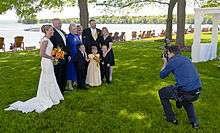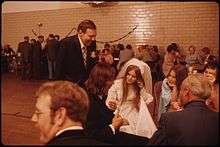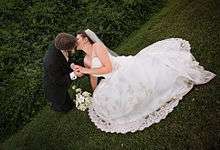Wedding photography

Wedding photography is the photography of activities relating to weddings. It encompasses photographs of the couple before marriage (for announcements, portrait displays, or thank you cards) as well as coverage of the wedding and reception (sometimes referred to as the wedding breakfast in non-US countries). It is a major branch of commercial photography, supporting many specialists.
History

Like the technology of photography itself, the practice of wedding photography has evolved and grown since the invention of the photographic art form in 1826 by Joseph Nicéphore Niépce.[1] In fact, an early photograph, recorded some 14 years after the fact, may be a recreation for the camera of the 1840 wedding of Queen Victoria to Prince Albert. However, in the early days of photography, most couples of more humble means did not hire a photographer to record the actual wedding itself. Until the later half of the 19th century, most people didn’t pose for formal wedding photos during the wedding. Rather, they might pose for a formal photo in their best clothes before or after a wedding. In the late 1860s, more couples started posing in their wedding clothes or sometimes hired a photographer to come to the wedding venue. (See the gallery at White wedding.)
Due to the nature of the bulky equipment and lighting issues, wedding photography was largely a studio practice for most of the late 19th century. Over time, technology improved, but many couples still might only pose for a single wedding portrait. Wedding albums started becoming more commonplace towards the 1880s, and the photographer would sometimes include the wedding party in the photographs. Often the wedding gifts would be laid out and recorded in the photographs as well.
At the beginning of the 20th century, color photography became available, but was still unreliable and expensive, so most wedding photography was still practiced in black and white. The concept of capturing the wedding "event" came about after the Second World War. Using film roll technology and improved lighting techniques available with the invention of the compact flash bulb, photographers would often show up at a wedding and try to sell the photos later. Despite the initial low quality photographs that often resulted, the competition forced the studio photographers to start working on location.

Initially, professional studio photographers might bring a lot of bulky equipment, thus limiting their ability to record the entire event. Even "candid" photos were more often staged after the ceremony. In the 1970s, the more modern approach to recording the entire wedding event started evolving into the practice as we know it today, including a more "Documentary photography" style of photography.
Technology
During the film era, photographers favored color negative film and medium-format cameras, especially by Hasselblad. Today, many more weddings are photographed with digital SLR cameras as the digital convenience provides quick detection of lighting mistakes and allows creative approaches to be reviewed immediately.
In spite of this trend, some photographers continue to shoot with film as they prefer the film aesthetic, and others are of the opinion that negative film captures more information than digital technology, and has less margin for exposure error. Certainly true in some cases, it should be noted that exposure latitude inherent in a camera's native Raw image format (which allows for more under- and over- exposure than JPEG) varies from manufacturer to manufacturer. All forms of RAW have a degree of exposure latitude which exceeds slide film - to which digital capture is commonly compared.
Technology has evolved with the use of remote triggers and flash synchronization. Wedding photographers are now able travel light and yet have the ability to use creative lighting.
Approaches



Two approaches to wedding photography are traditional and photojournalistic. Many wedding photographers will fall somewhere in between the extremes represented by these two descriptions.
Traditional wedding photography provides for more classically posed images and a great deal of photographer control during the ceremony.
A Photojournalist style of wedding photography takes its cue from editorial reporting styles and focuses more on candid images with little photographer interaction; a wedding photojournalist typically shoots images quickly using available light or on-camera flash rather than using traditional, formal posing techniques and studio lights. The Wedding Photojournalist Association was founded in 2002 and is an international, membership-based organization dedicated to wedding photojournalism. The association is a networking organization for wedding photojournalists, as well as a search engine allowing individuals to research different wedding photojournalists. Every year there are five main contests, 4 quarters and one of Bride Magazine. They accept Trash the Dress contest category in 2008.[2]

A third style is a fashion-based approach. In contemporary/fashion-based wedding photography, a photographer will combine candid images of the events of the day with posed images that are inspired by editorial fashion photography This style often involves more innovative and dramatic post-processing of images.
A fourth style that is popular in Asian countries, especially in China, is wedding studio photography (Chinese: 婚纱摄影; pinyin: hūn shā shè yǐng). Typically, couples will make an appointment with a studio for an in-studio or a location shoot, with support from a hair stylist and make-up artist in addition to the photographer and the couple. The couple will go through many changes of clothing and backgrounds in a similar manner to the fashion based approach.

The term contemporary wedding photography is used to describe wedding photography that is not of a traditional nature. The emphasis in contemporary photography is to capture the story and atmosphere from the day, so that the viewer has an appreciation of what the wedding was like, rather than a series of pre-determined poses.
Albums, prints, other products, types of photos

A contemporary wedding photographer will usually provide some or all of the following:
Indoor photography at a church, temple, or other private venue during the ceremony and reception. Outdoor photography (often at a park, beach, or scenic location on the day of the wedding and/or for engagement photos). Both posed and candid (photojournalistic) shots of the wedding couple and their guests at the religious or civil ceremony, and the reception that follows. Formal portraiture in the studio (for either the wedding and/or the engagement photos). Digital services, such as digital prints, slides shows and online galleries. Albums (either traditional matted albums or the more contemporary flush mount type of album).
The range of deliverables that a wedding photographer presents is varied. There is no standard as to what is included in a wedding coverage or package, so products vary regionally and from across photographers, as do the number of images provided.
Most photographers provide a set of proofs (usually unretouched, edited images) for the clients to view. Photographers may provide hard copy proofs in the form of 4x5 or 4x6 prints, a "magazine" of images with thumbnail sized pictures on multiple pages. Alternatively, they will provide an online proof gallery. The images will sometimes include a digital watermark/company logo on the images. Some photographers provide these proofs for the client to keep, and some photographers require the client to make final print choices from the proofs and then return them or purchase them at an additional cost.

There are a wide variety of albums and manufacturers available, and photographers may provide traditional matted albums, digitally designed "coffee table" albums, contemporary flush mount albums, hardbound books, scrapbook style albums, or a combination of any of the above. Albums may be included as part of a pre-purchased package, or they may be added as an after-wedding purchase. Not all photographers provide albums; some may prefer to provide prints and/or files and let clients make their own albums.
Most photographers allow clients to purchase additional prints for themselves or their families. Many photographers now provide online sales either through galleries located on their own websites or through partnerships with other vendors. Those vendors typically host the images and provide the back end sales mechanism for the photographer; the photographer sets his or her own prices and the vendor takes a commission or charges a flat fee.
Some photographers also include high resolution photograph files in their packages. These photographers allow their clients limited rights to reproduce the images for their personal use, while retaining the copyright. Not all photographers release files and those who do will most likely charge a premium for them, since releasing files sometimes means giving up any after wedding print or album sales for the most part. In the cases where photographers release the high resoluton images they are usually supplied on CD, DVD or USB Stick however, this depends on the individual companies and it's recommended the client(s) checks what is included with the photographers wedding photography package before signing any contracts.
The owner of the pictures' copyright is often explicitly stated in the contract for photographic services.[3] Without such explicit statement, the owner of the pictures' copyright will depend on the country involved as copyright laws vary from country to country. Photographers who do not retain copyright of the images often charge more for their services. In these cases, the photographer provides the client with the digital images as part of the wedding package. The client then has unrestricted use of the images and can print any that they may desire. Similarly, there are some photographers that offer joint copyrights of the digital images so they can also have unrestricted use of the images for reasons such as advertising.
Types of photos requested may be "first look" where the bride and groom see each other before the ceremony for first reaction photos rather than first seeing each other as the brides walks down the aisle. Another type of "first look" photo may be having the photo shot of the father of the bride seeing the bride for the first time when she is just about to walk down the aisle with him.
Profession

As a wedding is a one-time event, the photographer must be prepared for the unexpected. Shooting a wedding is both exhausting and invigorating as the photographer is constantly looking for good angles and opportunities for candid shots. Communication and planning time-lines before the event will alleviate many of the stresses associated with photographing a wedding. The ability to tactfully take charge also helps - particularly when photographing large groups or families - a common expectation after the ceremony. Having a run list with all of the expected shots is also a useful tool. A photographer may work with an assistant who can carry equipment, arrange guests, and assist with clothing adjustments or holding of reflectors.
Some wedding photographers have an office or studio which can double as a retail photography studio. In bigger cities, one might find dedicated wedding studios that only shoot weddings and may have large studios equipped with make-up, hair, and gowns ready for the bride to wear. Other wedding photographers work out of a home studio, preferring to photograph on location. These home based photographers may hire additional photographers to assist them if the wedding program is large or otherwise unmanageable by a single photographer.
Professional organizations
Organizations such as the Professional Photographers of America (PPA), Professional Photographers of Canada (PPOC), Wedding and Portrait Photographers International (WPPI) and Wedding Photojournalist Association (WPJA) support the art and business of wedding photography. WPJA awards an annual Photographer of the Year Award to recognize the best in wedding photojournalism.
In the UK there are many organiations including the Master Photographers Association (MPA), Society of Wedding and Portrait Photographers (SWPP), British Institute of Professional Photography (BIPP) and the National Photographic Society (The NPS).
Standards and requirements for professional organizations vary, but membership often indicates a photographer is insured. Professional organizations offer training, professional competition, and support to members, as well as directory services to help with marketing and organise conventions.[4][5]
See also
References
- ↑ Baatz, Willfried (1997). Photography: An Illustrated Historical Overview. New York: Barron’s. p. 16. ISBN 0-7641-0243-5.
- ↑ Wedding Photojournalist Association - WPJA
- ↑ http://www.abc.net.au/catapult/askexpert/s1732417.htm
- ↑ Lewis, Charles. (1999). "The Art World Of Wedding Photography: Professional Boundaries". In Griffin, Robert; Gibbs, William; Wiegmann, Beth (eds) Visual Literacy in an Information Age. International Visual Literacy Association. ISBN 9780945829119. pp215–222.
- ↑ Kim, Kenny. (2010). Wedding Photographer's Planner, Wiley, Hoboken, NJ, USA. ISBN 9780470872994. p249.
| Wikimedia Commons has media related to Wedding photography. |
